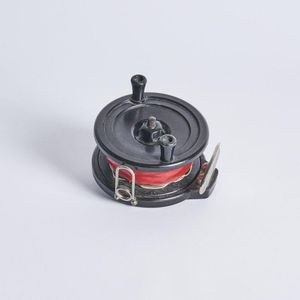Vintage Bakelite Fly Reel with Metal Guard
A vintage Steelite Bakelite and wood fly reel, made from Bakelite with metal guard. reg number 1869, 23.4.31, with diameter 12 cm, width 8.5 cm
You must be a subscriber, and be logged in to view price and dealer details.
Subscribe Now to view actual auction price for this item
When you subscribe, you have the option of setting the currency in which to display prices to $Au, $US, $NZ or Stg.
This item has been sold, and the description, image and price are for reference purposes only.
- Bakelite - Bakelite was the first completely synthetic man-made substance. Bakelite was invented in 1909 by an independent New York chemist Leo H. Baekeland. It was called the "material of a thousand uses" and used to make everything from car parts to jewellery.
Although nearly all plastic from this period is known as ?Bakelite', it is important to remember that this is an umbrella term that covers many different early plastics such as Lucite and cellulose acetate, and includes Bakelite.
We often think of the colour of Bakelite items as dark brown, but it was manufactured in various colours including yellow, butterscotch, red, green and brown.
Bakelite could also be transparent, or marbleised by mixing two colours. Plastics were cheap to produce and could be moulded or carved in a huge variety of ways.
Bakelite is most commonly associated with radio cases of the 1930s, telephones and kitchen utensils, but it was also used extensively in jewellery manufacture.
Early designs from the 1920s were plainer and simpler than later examples. Geometric and floral patterns typical of Art Deco styling were popular.
During its heyday in the 1930s, Bakelite jewellery was stocked by the most prestigious stores, such as Saks, Harrods and Macy?s, who dedicated a shop window display to it in 1935.
Coco Chanel featured Bakelite items in her accessories collection and the material was praised frequently in Vogue magazine.
Manufacture of some consumer Items were suspended in 1942 in order to concentrate manufacturing on the war effort.
Small items made of Bakelite are now valuable collectables. Andy Warhol was an avid collector, and when he died in 1987, his pieces sold for record prices at Sotheby's. - Registered Numbers - Between 1842 and 1883, a diamond- shaped mark was used to identify items as British-made, which classified the item according to the material from which it was manufactured, as well as the date of registration. This system was discontinued in 1884 when a numbering system was introduced.
Design registration is for "what and item looks like", and is not a patent ("how something works") or trade mark ("what it is called").
The registered number is usually on an under-surface of an object (on the base of ceramics) and oftern shown as "Rd. No. 99999", sometimes surrounded by a rectangular box.
The table below lists the year, and the first registered number for that year:
1884 1
1885 18,993
1886 39,547
1887 61,207
1888 87,266
1889 111,664
1890 140,481
1891 160,613
1892 183,259
1893 203,348
1894 223,861
1895 244,726
1896 266,237
1897 288,848
1898 309,956
1899 328,527
1900 349,120
1901 367,628
1902 380,979
1903 401,944
1904 422,489
1905 428,004
1906 469,160
1907 486,464
1908 516,375
1909 533,561
1910 546,084
1911 561,570
1912 585,707
1913 608,541
1914 627,887
1915 642,613
1916 651,079
1917 655,001
1918 662,576
1919 665,728
1920 664,869
1921 676,491
1922 685,412
1923 691,571
1924 695,944
1925 705,943
1926 716,386
1927 723,430
1928 725,899
1929 740,459
1930 741,336
1931 757,945
1932 767,110
This item has been included into following indexes:
